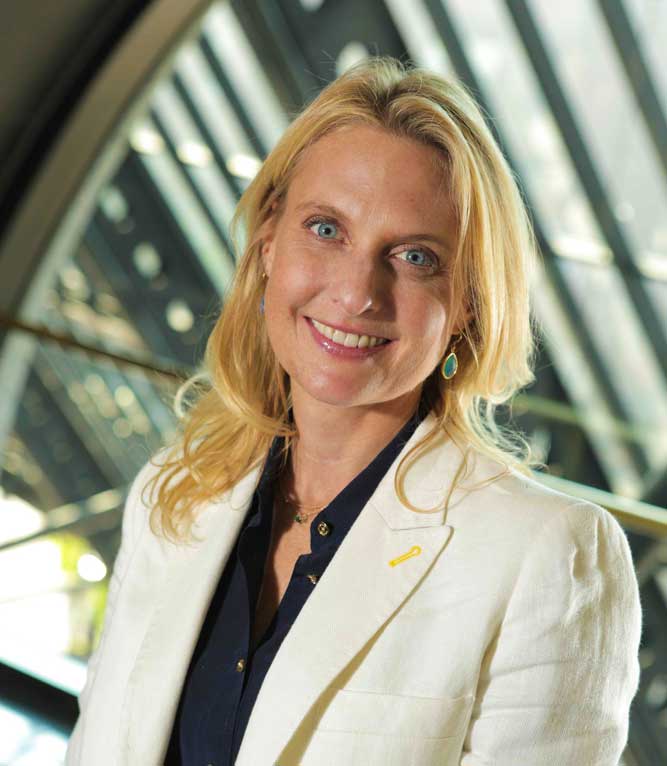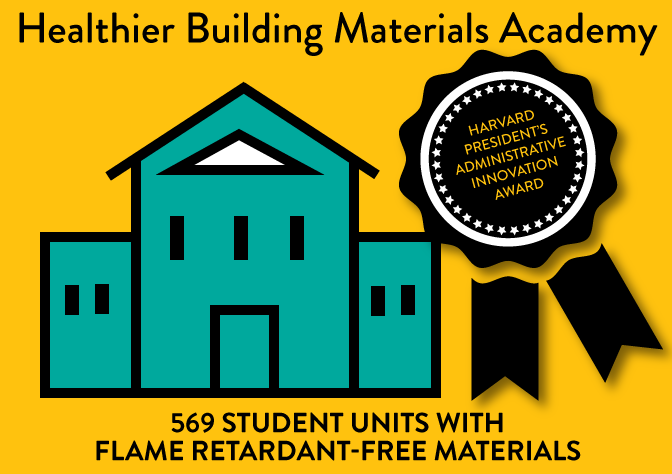Harvard Targets a Clean Sweep of Harmful Flame Retardants on Campus
“As consumers we must demand greater transparency for the products we buy, and that begins by acting on the scientific research that clearly shows by eliminating harmful chemicals of concern we can protect human health and enhance well-being.” —Heather Henriksen, Director of Harvard University’s Office for Sustainability
There is a growing awareness that toxic chemicals unnecessarily used to manufacture everyday products and building materials have harmful health impacts to people. To successfully address these chemicals of concern in the built environment requires commitment, buy-in and a road map for effective action.
Harvard University is taking action on this issue to enhance the health and productivity of its community of over 37,000 students, faculty, and staff.
Heather Henriksen, Director of Harvard’s Office for Sustainability and her colleagues across the University’s Schools and departments are forging a unique partnership with faculty to use the latest in cutting-edge research to identify harmful chemicals used in buildings across campus and take steps to reduce exposure.
Spurred by clear scientific evidence and a change in fire safety codes, they began with a project to eliminate the use of harmful chemical flame-retardants in upholstered furniture. “It’s all part of a larger focus on translating Harvard’s research into practice and reinforcing our belief that well-being must be a core component of an organization’s sustainability strategy,” says Henriksen, who serves on the Board of the Health Product Declaration Collaborative.

HEATHER HENRIKSEN – HARVARD UNIVERSITY
In collaboration with:
Harvard Center for Health and the Global Environment
Green Science Policy Institute
Silent Spring Institute
Healthy Building Network
Google
Stepping Stones
1
We created a foundation for institutional change by integrating health and well-being into plans, standards and practices.
2
We educated the community by sharing the research of subject matter experts.
3
We leveraged institutional partnerships to gain multi-stakeholder participation.
Making Campus-wide Clean Up A Breeze
Busy decision makers require clear choices for replacing furniture products with ones that meet Harvard’s health standards, as well as the community’s aesthetic standards. Henriksen and her team knew they had to devise a plan with clear guidelines that would make it easier for people to change their behavior.
As a first step, they updated the University-wide Green Building Standards in 2014 to include healthy material requirements and facilitate the disclosure of health and environmental impacts of products that are used in capital projects. That same year, Harvard issued its first Sustainability Plan and included Health and Well-being as one of its five areas of focus.
“With so many people focused on climate and energy, centering our plan on intergenerational well-being put us in wide open territory for making human health a priority on campus,” says Henriksen.
When the Massachusetts fire safety code was updated in 2015 to reflect the California fire safety standard, the opportunity to take action on chemical flame retardants became clear. OFS collaborated with Harvard Strategic Procurement to survey all its furniture vendors on availability of chemical flame retardant-free products. Simultaneously, the Environmental Health & Safety and Energy & Facilities department performed a joint review of regulatory changes.
“With so many people focused on climate and energy, centering our plan on intergenerational well-being put us in wide open territory for making human health a priority on campus,” says Henriksen.
OFS then brought in scientists from Harvard and the Green Science Policy Institute for a series of educational forums attended by over 100 key stakeholders across campus that provided an overview of the research proving a health risk from these chemicals of concern and the role individuals can play in reducing exposure.
In 2015 Harvard became the first university to sign a national pledge to specify and procure fire-safe products free of chemical flame-retardants. Other signatories include Kaiser Permanente, Facebook, Blue Cross Blue Shield Massachusetts, and Autodesk.
A Chemical-Free Flame Retardant Tool Kit and Buyer’s Guide was designed to provide Harvard purchasers, project managers, facilities leaders and outside vendors with background on the problem, and buying tips to ensure healthier furniture.
Using the Campus as a Living Lab for Healthier Buildings
Researchers at Harvard’s T.H. Chan School of Public Health, Harvard Medical School and the John A. Paulson School of Engineering and Applied Sciences have made significant discoveries concerning the impact of harmful chemicals on public health.
Henriksen’s team has partnered with these faculty, the Harvard Center for Health and the Global Environment, and the Silent Spring Institute to identify opportunities to use the campus and its buildings as a living lab for ongoing research to better understand exposure to chemicals from the built environment. The three groups also launched the Healthy Green Campus Network to encourage higher education to work together on research related to health and the built environment. OFS is also partnering with like-minded organizations and business like Google to accelerate the market shift toward reducing the presence of harmful chemicals in the built environment.
489 new units being renovated will have chemical flame retardant-free window treatments and the 80 furnished units will include chemical retardant-free furniture; while meeting all fire codes.
The largest project to date to incorporate healthier products is a recent renovation of graduate student housing where all 489 new units being renovated will have chemical flame retardant-free window treatments and the 80 furnished units will include chemical retardant-free furniture; while meeting all fire codes. OFS is also partnering with several other major capital projects throughout to pilot the use of healthier building materials.
The RESULTS!

